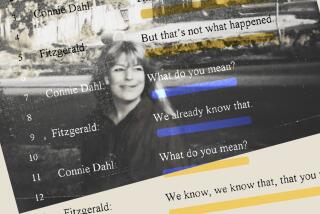TV REVIEW : Move Over, Geraldo, Here Comes KGTV’s Marti Emerald
- Share via
SAN DIEGO — Geraldo Rivera made the ambush interview famous.
He’d run after some poor sap, cameras rolling, badgering him with accusatory questions. The suspect, er, subject would take on the glazed expression of a deer caught in a car’s headlights. If the pursued was silly enough to stop running, Rivera would gleefully confront the man, going for the jugular with every question.
KGTV (Channel 10) reporter Marti Emerald is no Geraldo. However, judging by the “10News Troubleshooter Special,” airing at 10 p.m. today, her new career ambition is to be the Geraldo of San Diego.
The special is a collection of Emerald’s “Troubleshooter” segments (previously aired on Channel 10’s newscasts) interspersed with a “consumer quiz,” shopping tips and tests of products. It was taped in front of a live audience, making it a direct descendant of “Fight Back!” (David Horowitz’s popular syndicated consumer show), not to mention the “I’m mad as hell” studio atmosphere of the old and scary “Morton Downey Show.”
In many ways, the studio audience seems superfluous. Though representatives of various law enforcement agencies are on hand to impart useful information about how to avoid scams, the studio audience adds little to the show, beyond answering quiz questions and giving the program a populist touch, seemingly obligatory for this type of show.
The real star of the program is the ambush interview. Emerald uses it with enthusiasm.
In the opening segment, a rerun of a feature about a Long Beach church that appears to exist for no other reason than to raise money, she confronts a man while he is drinking his morning coffee at home. Later, she chases a church representative down an alley.
Even Geraldo occasionally attempted to control his excitement at cornering his prey. Emerald can’t resist sarcasm. She stops just short of winking at the camera. When a subject says he can’t talk to her, she says, “Ah, gee, that’s too bad.”
On more than one occasion, the producers show Emerald attempting to coax subjects into talking in front of the camera.
“I promise I don’t bite,” she tells a doctor, who didn’t want to come out from behind a curtain.
It’s not hard to understand why someone would try to hide from Emerald. This type of reporting can easily turn into trial by camera. Anyone would be startled to find a television reporter and camera on their doorstep in the morning.
An innocent person can look extremely guilty running away from a TV news crew. The theory that someone with nothing to hide would gladly speak to a reporter is grossly unfair. A person has a right not to answer questions.
The titillating and sensational aspects of ambush journalism are hard to deny.
From an audience’s perspective, it is fascinating to watch a subject cringe at the sight of a camera. With the videotape rolling, they squirm and fidget, and the audience feels as if they are part of the kill, reacting with the same “Yeah, get the bum” attitude that makes shows like “Cops” a voyeuristic thrill.
Yet, there is something unsettling about television news acting as judge and jury. It decides when to show somebody in an embarrassing situation, who to ambush and who to treat in a mannerly fashion.
Emerald’s version is equally disconcerting. Her expression and vocal tone often seems to say, “Hey, we all know what’s really going on here.”
There’s an awkward feeling that the ironic twist, the slam is more important than getting to the truth. In one segment, a VCR, undamaged except for a shorted $1.50 fuse, is taken to several repair shops. The knife is slid in when the shops give a wide range of estimates, some close to $100, to repair the VCR.
The crowd cheers. But since when is an estimate proof that the shops would have actually charged that much? A repairman may have estimated the repair at $75, but he might have found the real problem and solved it inexpensively.
That may not have made for great television, but it certainly was a possibility.
The special does demonstrate some examples of consumer reporting at its best, and it does shows that there is a place for aggressive consumer reports in television news. Channel 10 is the only station in town really doing it with any consistency and authority.
In the special, which moves at a rapid-fire pace, the station effectively demonstrates how some recyclers in town are shortchanging customers by misweighing bags of aluminum cans. When the Channel 10 crew accompanies an undercover sting operation on home-improvement contractors, it dramatically illustrates a problem and tells people what they should beware of when dealing with unlicensed contractors. The segment lacks the sensationalism of the ambush technique, but it effectively makes its point.
More than anything, though, the special comes across like an advertisement for Channel 10 news. Several times during the show, Emerald plugs the news.
Near the end, she introduces a taped segment on the “Troubleshooter” team, presenting them like heroes of the Western world. The only thing missing is the theme music to “The Bridge on the River Kwai.” Producer J. W. August was introduced as “San Diego’s pit bull of news,” and Emerald made it clear that the team “solves thousands of problems a year” because Channel 10 is “committed to consumers in this county.”
It might be fun one day to burst into General Manager Ed Quinn’s office, point a camera in his face (chasing him down the hall would be a nice touch), and ask whether the sensational and titillating aspects of consumer reporting might be a large part of the station’s reason for that commitment.
More to Read
The complete guide to home viewing
Get Screen Gab for everything about the TV shows and streaming movies everyone’s talking about.
You may occasionally receive promotional content from the Los Angeles Times.






